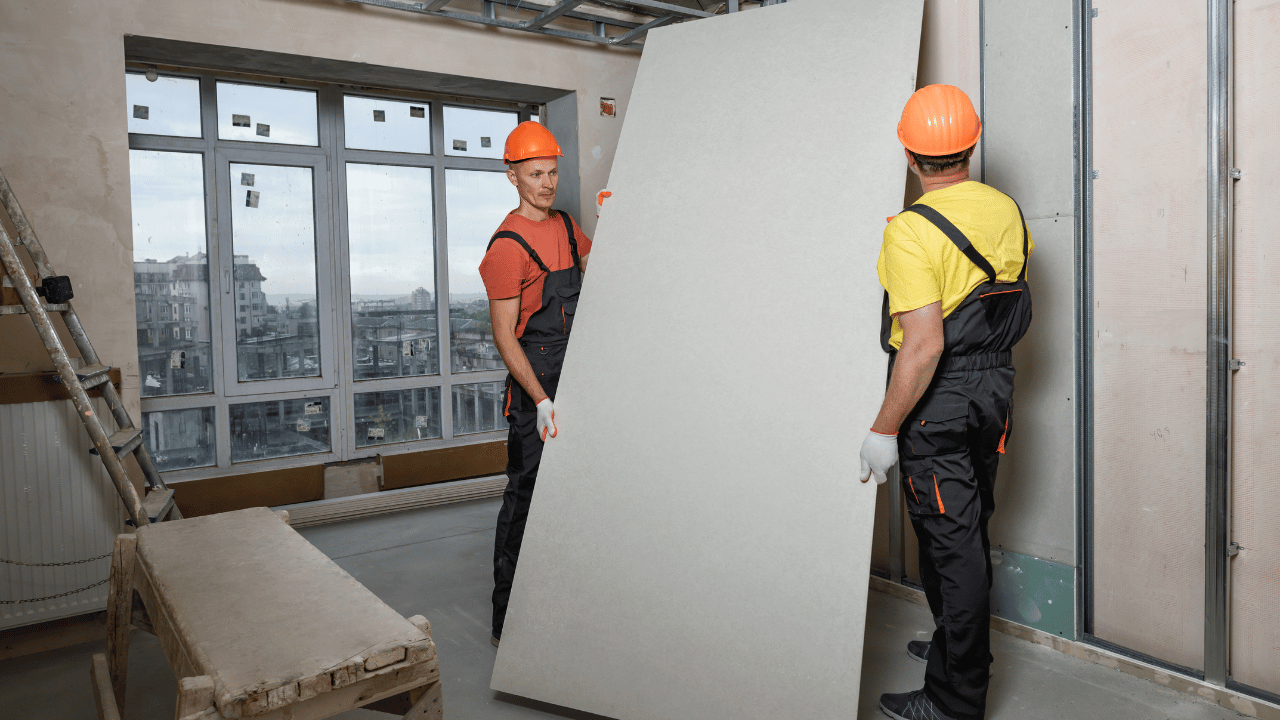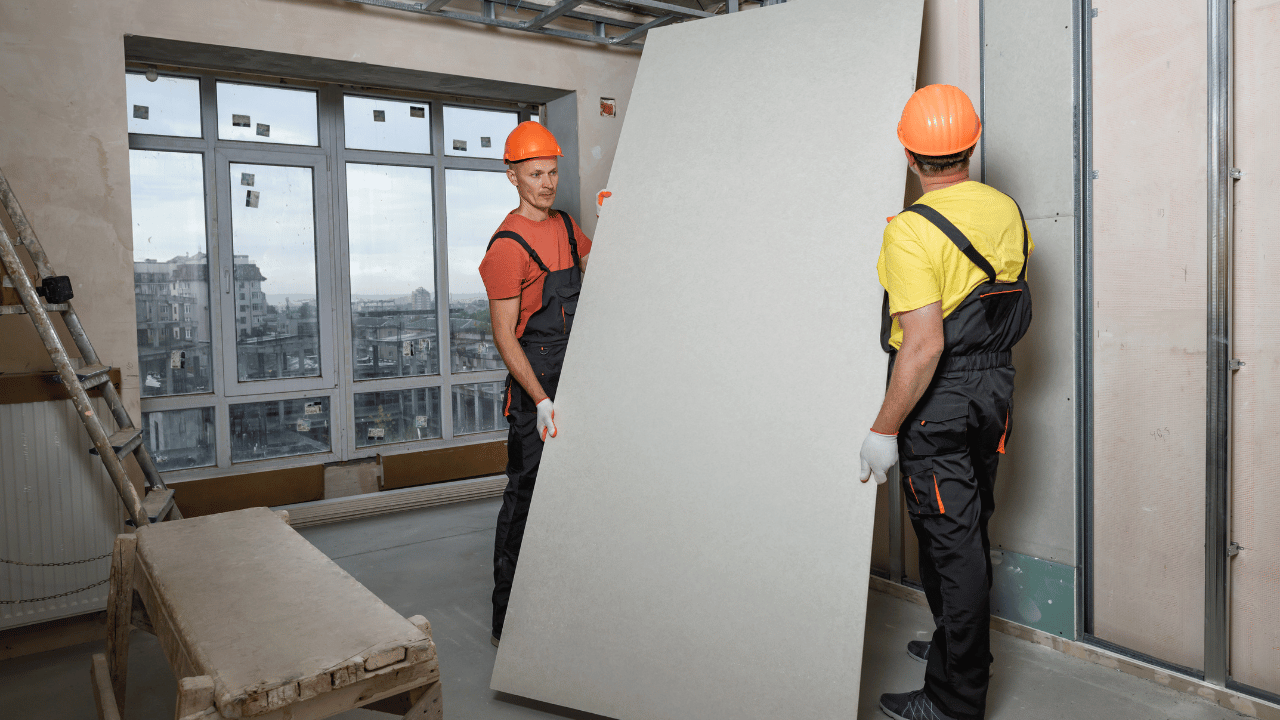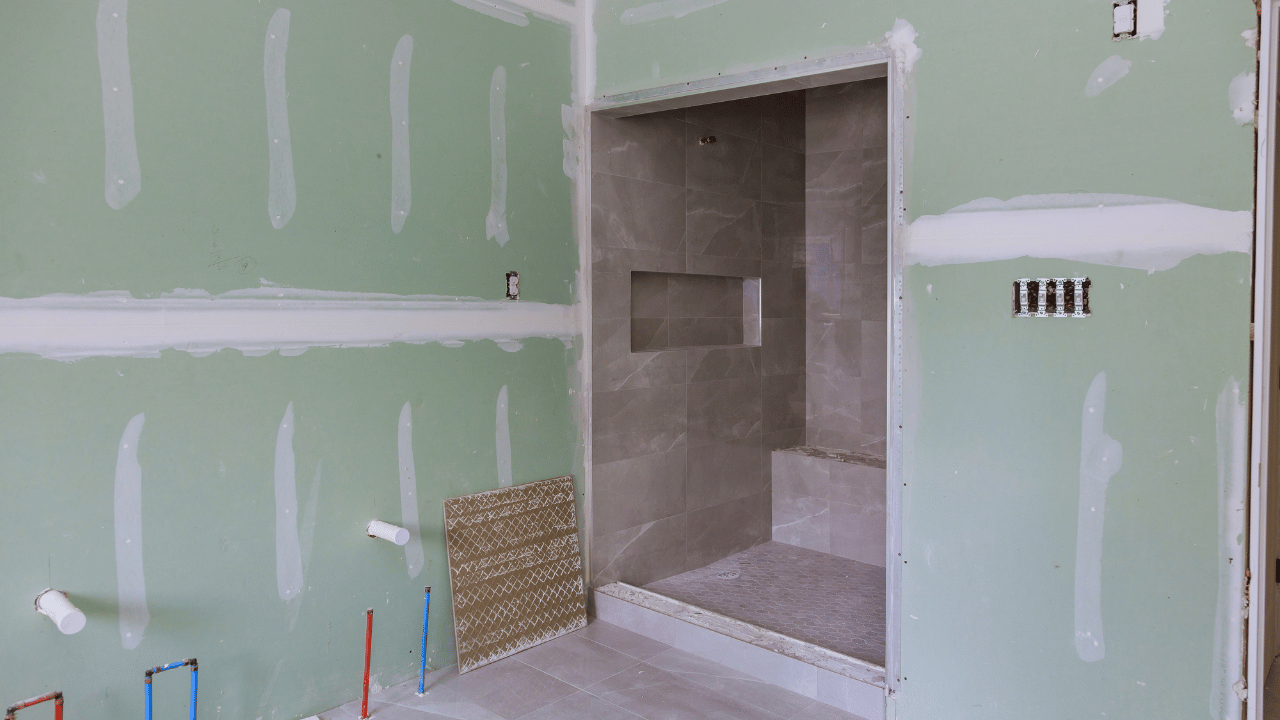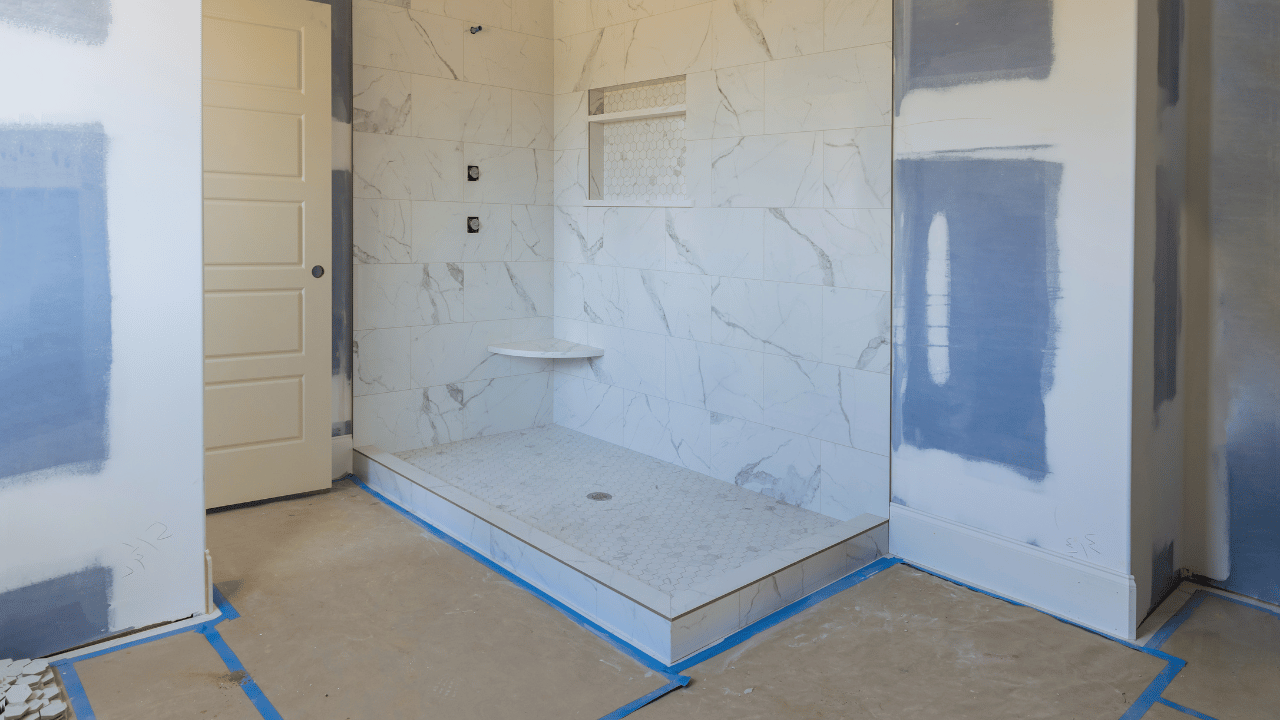Last Updated on October 21, 2023 by Pro Handyman Australia – Editorial Team
Often referred to by various names such as gypsum board, plasterboard, buster boards, custard boards, or gypsum panels, drywall is a predominant material used for crafting interior walls and ceilings. It is fundamentally composed of gypsum enveloped between two layers of paper. This construction material stands out for its gypsum core, which might be intertwined with materials like paper-fiber, fiber-glass, or a combination of these, along with foaming agents and other elements. These components not only enhance the plaster but also diminish flammability and the likelihood of mildew growth and water absorption. Beyond its structural benefits, the gypsum core also boasts soundproofing and fire-resistance properties, while the outer paper layers provide a paint-ready smooth finish.
Bathrooms, the sanctuaries of our homes, where we begin and end our days, deserve every ounce of attention we invest in them. As you embark on your bathroom remodel journey, one of the critical considerations is the type of drywall you should use. Given the unique challenges presented by a bathroom’s humid and wet environment, the choice of drywall isn’t merely cosmetic—it’s foundational to the longevity and durability of your renovation. In this blog post, we will delve into the world of drywall, evaluating the best options tailored for bathroom spaces, and ensuring that your revamped space not only looks exquisite but stands the test of time. Let’s explore the ideal drywall solutions to make your bathroom both beautiful and resilient.
Understanding Your Bathroom Drywall Options
Bathrooms present unique challenges due to their constant exposure to moisture and humidity. When remodeling or constructing, the type of drywall you select can significantly impact the durability and lifespan of your bathroom.

Decoding Drywall Types
- Standard Drywall (White Board): The most ubiquitous type, white board drywall is mainly chosen for interior spaces such as living rooms, bedrooms, and kitchens. Recognizable by its white facade on one side and a cardboard hue on the other, it comes in standard four-by-eight-foot panels.
- Moisture-Resistant Drywall (Green Board): A step up from the standard, green board is engineered to resist moisture, though it isn’t entirely waterproof. It serves well for bathroom walls and humid areas, but not for places in direct water contact, such as inside showers.
- Veneer Plastering Drywall (Blue Board): Designed specifically as a base for plastering, blue board is also moisture-resistant. Its unique composition allows mortar application without needing taping, making it suitable for bathrooms and as a foundational layer for tiles.
- High Moisture Resistance Drywall (Purple Board): A top-tier choice for bathrooms, purple board is adept at resisting moisture, mold, and mildew. Its heightened resistance attributes justify its slightly higher cost.
- Innovative Solutions (Paperless Drywall): Made from a combination of gypsum and fiberglass, this new-age drywall provides substantial moisture resistance. However, it’s advised to avoid using it in direct water contact areas like showers.
- Safety First (Type X Drywall): Crafted to be fire-resistant, Type X drywall stands out with its off-white or ivory hue. It’s more challenging to cut and may necessitate the use of a saw.
Diving into Bathroom Drywall Options

Green Board Drywall A preferred choice for bathrooms and other high-humidity environments, the Green Board drywall bears a striking resemblance to the standard White Board drywall. Its standout feature, however, is its moisture-resistant paper facing. This green-hued drywall is crafted to endure the elevated moisture levels typical in bathrooms but isn’t designed to be in direct contact with water. Though it offers heightened moisture resistance, it isn’t completely impervious to water. Hence, for bathroom applications, incorporating additional waterproofing measures like vapor barriers and tiles is advisable.
Advantages:
- Effortless repairability.
- Ease of cutting and installation.
- Demonstrates resistance to moisture and mold.
- Perfectly suited for bathroom walls.
- Ideal for moderately damp settings.
Limitations:
- Pricier than standard drywall.
- Offers only partial water resistance.
- Lacks fire-resistance, making it unsuitable for high-fire risk areas.
Purple Drywall Another stellar contender for bathroom spaces is the Purple Board drywall. While it shares similarities with regular and Green Board drywalls, it outshines the Green Board in terms of resistance to moisture, mold, and mildew. The gypsum core is fireproof, and its paper surface has undergone treatment to fortify its defense against mold and mildew proliferation. Distinguishable by its purple hue, this drywall is adept at enduring water exposure, making it a prime choice for spaces demanding augmented mold and moisture defense.
Advantages:
- Simplified and swift installation.
- Exhibits robust moisture resistance.
- Fire-resistant nature.
- Acts as a barrier to mold and mildew growth.
- Ideal for both bathroom walls and ceilings.
- Can function as a tile backer board in dry regions.
- Boasts square-cut edges paired with a sleek finish.
Limitations:
- Commands a higher price point compared to regular and Green Board drywall.
- Its weight might pose challenges for DIY endeavors.
Cement Board Drywall: The Moisture-Resistant Heavyweight
For spaces continually exposed to high levels of humidity, such as bathrooms and showers, the Cement Board drywall emerges as an unbeatable choice. Its stellar composition, a blend of cementitious materials fused with reinforcing fibers, creates a robust and unwavering panel. Not only does it stand up against moisture, but it also resists mold and mildew with commendable efficiency. Further elevating its value is its ability to serve as a trustworthy substrate for tile installations, ensuring a fortified and waterproof surface.
Primarily used on bathroom walls and floors, especially in areas with direct water exposure like tub surrounds and shower enclosures, this drywall ensures a water-resistant backing for tiles or other aesthetic finishes. To make the most of its waterproofing capabilities, it’s crucial to pay meticulous attention to details during installation, especially at the corners and while sealing the joints.
Available in various sizes and thicknesses, the Cement Board drywall is often the first choice for bathroom renovations, chiefly due to its resistance to moisture and impressive durability.
Advantages:
- Stellar moisture resistance.
- Acts as a formidable barrier against mold.
- Naturally fire-resistant.
- Serves as a dependable foundation for tile installations.
- Provides a degree of design flexibility.
Limitations:
- Weighs more than conventional drywall.
- Pricier than its regular counterparts.
- Requires expertise for installation.
Blue Board Drywall: The Aesthetic Pleaser
Also referred to as Blue Gypsum Board or Plaster Baseboard, Blue Board drywall is tailor-made for veneer plastering pursuits. Its distinctive blue-hued paper front is not just for aesthetics but also acts as a quick visual differentiator from other types of drywall.
Though it sports a gypsum core and a blue paper facing for enhanced moisture resistance, it doesn’t quite match up to the water resistance of the Purple Board, Cement Board, or Green Drywall. Its primary function remains to offer a smooth and enduring base for veneer plaster finishes.
If moisture resistance is paramount for your project, it might be worth exploring options like the Green Board or Purple drywall.
Advantages:
- Incorporates sound-dampening qualities.
- Simplified and quick installation process.
- Ease of repair.
- Elevates bathroom aesthetics.
Limitations:
- Offers moderate moisture resistance.
- Tends to be costlier than several other drywall variants.
Making the Right Bathroom Drywall Decision
Your bathroom’s specific needs dictate the best drywall choice. For areas in direct contact with water, such as shower and bath surrounds, cement board reigns supreme. Walls and ceilings, on the other hand, benefit from the moisture-resistant properties of both green and purple boards.
Weighing the Pros and Cons of Drywall

When deciding on wall solutions, understanding the advantages and limitations of drywall can guide your decision.
Advantages of Drywall:
- Ease of Installation: Drywall is manageable if you possess fundamental carpentry skills. The process entails making precise cuts and affixing the drywall to the studs.
- Affordability: Among the most cost-effective wall coverings, standard drywall can be priced as low as $.50 per square foot.
- Stability: With a typical coverage of four feet and studs spaced every 16 inches, using screws at the standard intervals ensures optimal stability.
- Versatility: Drywall offers resistance options against fire and moisture, adapting to various needs.
- Repairable: Minor damages to drywall can often be fixed using standard repair kits.
- Decorative Flexibility: Drywall serves as a blank canvas, ready to be painted, repainted, or wallpapered.
- Load-bearing: Specialized drywall anchors can support heavy items without requiring a stud.
Drawbacks of Drywall:
- Finishing Challenges: While installing drywall is straightforward, achieving a polished finish can be challenging, especially for novices.
- Weight Concerns: Drywall panels are heavy, often necessitating teamwork to prevent damages during installation.
- Durability Issues: Despite its stability, drywall can be damaged easily. For instance, a harshly shut door can result in noticeable damage.
- Lack of Authenticity: If you desire a handcrafted and authentic wall appearance, drywall might not be the best choice.
- Outdoor Cutting Requirement: Cutting drywall indoors can be both messy and hazardous due to dust particles, making an outdoor space essential for this task.
- Choice Overload: With a plethora of drywall types available at varying prices, making the optimal choice for your needs can be daunting.
Guiding Principles for Selecting Optimal Bathroom Drywall

The Battle Against Moisture and Mold
Bathrooms are constantly exposed to moisture and elevated levels of humidity, making it essential to prioritize moisture- and mold-resistant drywall. While mold-resistant drywall can certainly inhibit mold growth, it’s essential to understand that it doesn’t completely eradicate the possibility of mold formation. Adopting a holistic approach by ensuring proper ventilation, diligent moisture management, and consistent cleaning can further safeguard against mold in bathrooms.
A Question of Waterproofing
It’s a common misconception that moisture-resistant drywall is synonymous with being waterproof. To truly waterproof your bathroom, particularly around areas such as showers and bathtubs, you might need to go the extra mile. Seek out drywall that not only resists moisture but is also innately waterproof. Additional measures like integrating vapor barriers, opting for waterproof paint, or tiling wet areas can further bolster protection against water damage.
Endurance and Longevity
Given the nature of bathrooms as high-traffic zones, it’s essential to opt for drywall that can withstand the onslaught of factors like humidity, moisture, and the occasional impact. Durability becomes a prime factor to consider to ensure that the installed drywall stands the test of time and usage.
Installation Nuances and Upkeep
While some types of drywall might appear enticingly simple to install, others, like the cement board, demand specialized techniques. Although many adventurous homeowners might be tempted to tackle drywall installation as a DIY project, seeking expertise from a seasoned contractor can ensure a flawless finish. This is especially crucial if you’re unfamiliar with the installation nuances or lack prior experience.
Staying Within the Bounds of Local Building Codes
Before commencing any construction or renovation project, it’s wise to acquaint yourself with the prevalent local building codes pertaining to drywall installation. Such codes, established by local municipalities or authorities, are in place to ensure the safety, structural integrity, and compliance of any construction project within their jurisdiction. Adhering to these codes guarantees that your bathroom remains compliant and avoids any potential regulatory pitfalls.
Ensuring Synchrony with Desired Finishes
The choice of drywall should also align with the finishes you envision for your bathroom, whether it be paint, wallpaper, or tiles. The drywall’s surface should be conducive to the adhesion or application of your preferred finishing touch, ensuring a seamless and lasting aesthetic appeal.
Additional Information:

Estimating Your Drywall Needs
Embarking on a drywall project necessitates a clear understanding of the materials you’ll require, ensuring efficiency and cost-effectiveness. The common practice is to determine the total surface area by multiplying the height and length of the walls. Once you have this value, divide by the area of a single drywall sheet. This technique aims to minimize both expenses and material wastage, preventing the over-purchase of sheetrock.
The Versatility of Gypsum Wallboard
Gypsum wallboard, commonly referred to as gypsumboard, has become an integral component in many DIY endeavors. Notably, a 1/2 inch gypsum wallboard is lighter than its counterpart in standard drywall sheetrock. Comprising over 20% water and enriched with glass fibers, gypsum wallboard boasts impressive fire-resistant properties. This makes it an ideal building material for walls, ceilings, and partitions in both residential and commercial spaces.
Mastering the Drywall Knife
An indispensable tool in the drywall toolkit is the wide-blade drywall taping knife. Begin by placing about two inches of compound on your blade’s edge. Starting from a room’s corner, the key is to apply the joint compound into the intersections between boards and any recesses. When addressing the seams, maintain your knife at approximately a 25-degree angle to facilitate the compound’s smooth application, ideally in one fluid motion.
The Utility of a Drywall Banjo
For larger-scale drywall projects, the drywall banjo comes to the fore. This tool is instrumental in mitigating issues like tape bubbling. Mirroring the mechanism of a scotch tape dispenser, the banjo allows simultaneous tape and mud application. As the tape progresses from the roll to the cutting edge, it undergoes a mud pass, ensuring consistency and quality in application.
Perfection with the Drywall Rasp
When working with drywall, especially around windows or larger holes, precision is paramount. The drywall rasp emerges as the go-to tool for refining and perfecting drywall cuts, allowing for a seamless fit and finish.
The Technique of Wet Sanding Drywall
Wet sanding involves using a damp sponge to refine and shave off excess taping compound post-drying. By gently rubbing the compound with the sponge, it softens and becomes amenable to smoothing. For this task, a robust, rigid sponge is optimal to achieve the desired finish without oversaturating the surface.
The Precision of a Drywall Router
The drywall router, essentially a spiral saw, is the epitome of accuracy when it comes to creating openings in drywall, especially for electrical boxes. This tool enables swift, precise cuts, negating the need for extensive measurements or marking, thus accelerating the installation process.
Conclusion

In the dynamic world of home renovations, the bathroom stands out as a space where both functionality and aesthetics must merge harmoniously. The choice of drywall plays an instrumental role in this balance. As we’ve delved into the various types of drywalls available, it becomes evident that not all are created equal, especially when faced with the unique challenges posed by bathroom environments. Moisture, humidity, and the potential for mold growth necessitate a careful selection. Opting for moisture and mold-resistant drywall variants, such as the green or purple board, can be the key to ensuring longevity, durability, and a healthy space. While the initial investment might be higher than standard drywall, the peace of mind and reduced maintenance costs in the long run make it a worthy choice. As always, understanding your bathroom’s specific needs, combined with informed choices, will pave the way for a remodel that stands the test of time.
